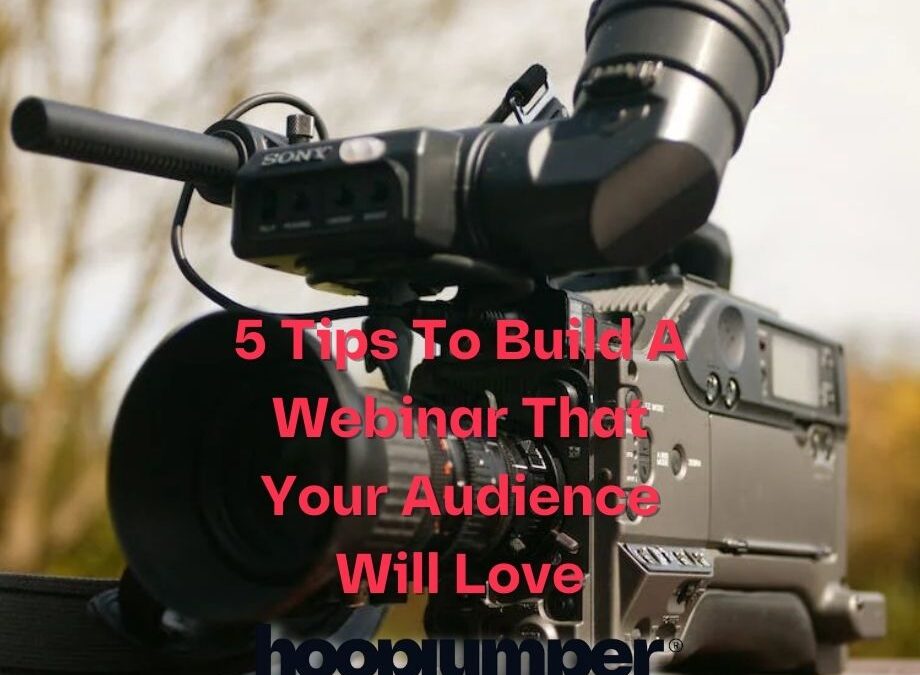In this week’s blog, we’ll talk about some tips to build a webinar that your audience will love to watch.
Webinars are great tools to market your business because they not only provide value to your audiences, but they also provide good content for your social media posts like Facebook and Instagram reels, or YouTube shorts.
Excellent webinars can resemble indie films – they leave you with a sense of euphoria, motivation, and readiness to conquer the world.
On the other hand, poor webinars can be compared to B-grade films – after two hours, you start to ponder how someone could have received payment for producing something so unashamedly dreadful.
So how do you build a webinar that will attract your target audience’s attention?
Here are five tips to do that.
Let’s begin.
Start By Asking: Does This Content Need A Webinar?
Webinars are not equally suited for all types of content. Certain ideas lend themselves particularly well to this format.
Here are some examples of topics that would be a good reason to build a webinar:
- A niche topic that is explored in-depth from a unique perspective
- A panel discussion focused on a current and relevant news-based issue in your industry
- A comprehensive tutorial that provides numerous examples and practical guidance
- A modified version of a conference presentation that was previously delivered
- An interview with a prominent industry expert or thought leader
It’s important to keep in mind that misleading participants with exaggerated promises of exciting content, only to fall short of their expectations (or concealing a marketing pitch as informative material), can result in upsetting individuals and damaging your credibility.
If you promote your webinar as exceptional, make certain that you can deliver on the level of quality you’ve advertised.
Once You Determine That Your Topic Is The Right One, Think About The Format And The Speakers.
To ensure the credibility and effectiveness of your webinar, it’s crucial to have experienced and knowledgeable experts as your hosts. Only then can you expect them to confidently and authoritatively speak about the chosen subject matter.
When choosing presenters for your webinar, it’s important to carefully assess their familiarity with the topic and comfort level in front of the camera.
This is particularly essential in handling unexpected questions that may arise during the session.
When organizing your webinar, you must determine the appropriate format for your selected topic.
Would you prefer a single-presenter format, an interview-style webinar with two speakers, or a panel discussion with multiple guests and a moderator?
Your decision on the complexity of the subject matter and the availability of adequately qualified speakers should influence your choice of format.
Now It’s Time To Consider The Technicals To Build A Webinar.
What platform works the best for what I’m trying to achieve? Am I running a webinar for a large audience? How large of an audience am I looking at?
These are just some of the things to consider when
scouting for a platform to run your webinar on. The size of your company and your attendee list will dictate how robust your hosting solution needs to be.
Another area to consider is audio. If you want to prevent a webinar from being ruined, it’s crucial to have high-quality audio.
Relying on the built-in microphones on your laptop can lead to tinny, distorted, or weak audio, even if your hardware is decent.
To avoid this issue, it’s recommended to use cabled headset microphones that will ensure clear and crisp audio for your presenters.
Once The Technicals Are Sorted Out, Write A Script.
Your webinar is highly likely to fail if you don’t have a script. Even experienced webinar producers and hosts depend on scripts because it can be challenging to talk for up to an hour, even if the topic is something you’re enthusiastic and knowledgeable about.
Think of a script as your all-in-one guide, compass, map, and GPS. It will keep you focused and make it easier to manage time.
Some people prefer to develop their script and slide deck at the same time to prevent redundancy and the temptation to read directly from the slides.
Finally, TEST Your Webinar Before Going Live.
You don’t want to have any unexpected hiccups on your webinar. It is essential to test your equipment before the live webinar and not assume that everything will go smoothly.
To ensure that everyone knows what they are doing and that your gear is working correctly, conduct at least one run-through several days before the live event.
That’s It! You’re Ready To Build A Webinar That Your Audiences Would Definitely Watch.
Organizing a webinar can appear to be time-consuming, but the advantages it offers can definitely make it worthwhile.
As you prepare for your webinar, bear in mind that the majority of the suggestions listed here are intended to increase audience engagement.
And once that webinar is done, you can use snippets of it to make good content to share on your website and social media pages.
HoopJumper can help you with that. You don’t have to stress yourself out with hours of editing, optimizing and posting trying to become a video star.
Just record a short video or audio on your iPhone/Smartphone and let HoopJumper® do the rest.
Contact us today to find out how HoopJumper can help you not only produce a good webinar, but also good video content from it.

